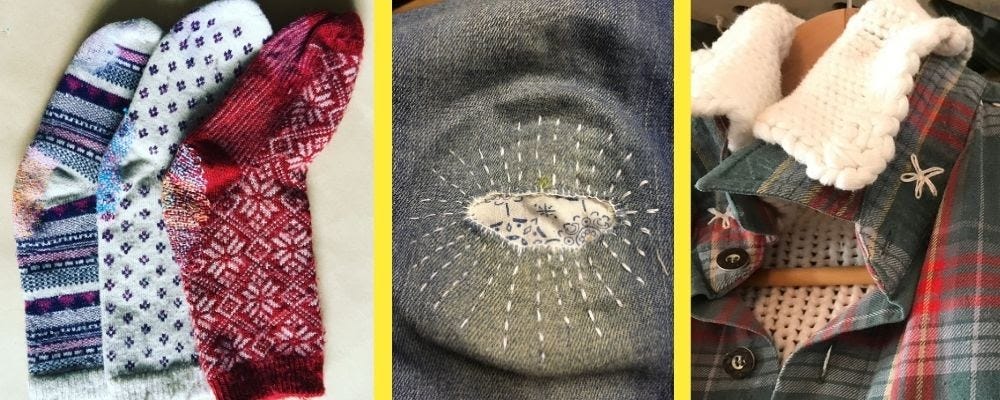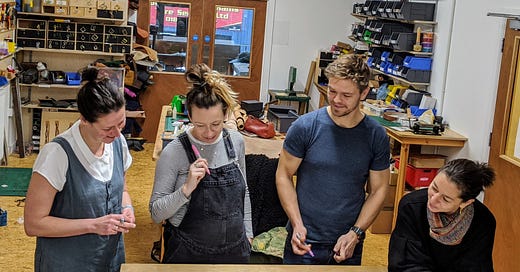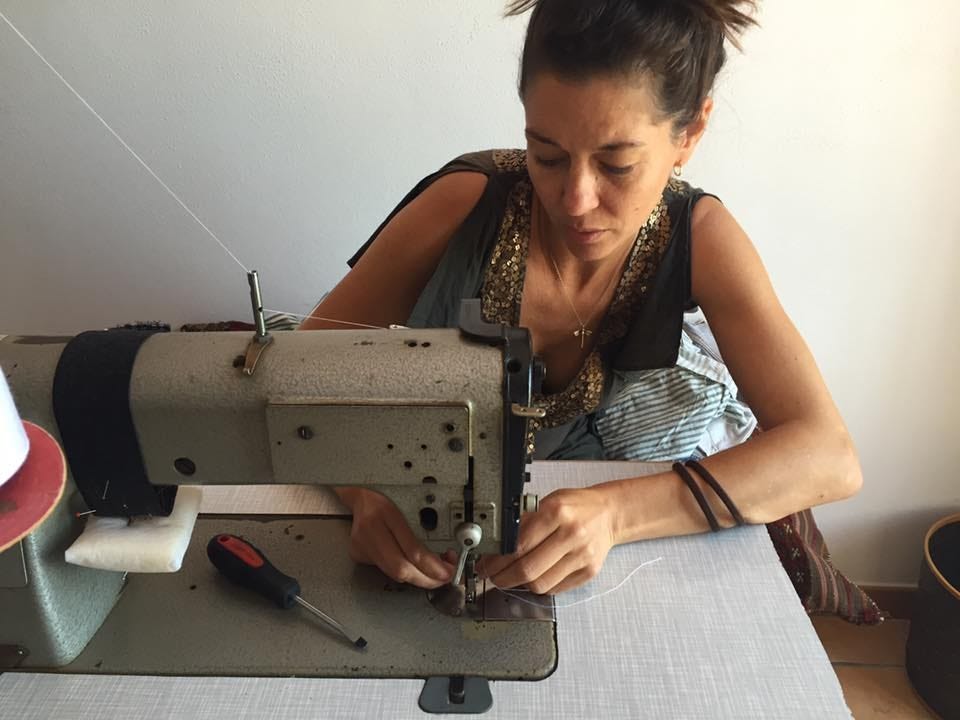Simple climate action // I S S U E # 2 4 // F A S H I O N
The gentle pleasure of repair
By Michael J Coren
Most of us have a piece of clothing we’ve never parted with. Mine is a pair of black Volcom surf shorts, with light pinstripes fastened and an unpolished brass button. There are lots of small touches: a gold and white band on the inside of the waistband where few would ever see it. A care label slips in the quote: “Be the change you wish to see in the world.”
That what fashion was at age 18 (at least in Florida), but the construction is flawless. It’s one of the most comfortable things I’ve ever worn, and versatile enough to pull double duty on a beach and then go out to dinner on a warm night along the Atlantic Ocean where I grew up. By now, I estimate, the shorts have been washed hundreds (upon hundreds) of times on adventures from Phnom Penh to Baja Sur. Except for a few stray threads, and a loose stitch here or there, there’s little that hints at nearly twenty years of wear and tear. And it still gets the occasional compliment.
I’ve searched for pieces like this ever since: an authentic aesthetic, and built with craftsmanship to outlast any fashion cycle. There’s a few more in my closet. That dress shirt from a New Orleans thrift store tailored by Mike Trotta, “tailor and haberdasher.” An especially warm wool cap. And a pair of perfectly cut black dress boots which is giving me the opportunity to meet many cobblers over my lifetime as I replace those soles every few year (someone stopped me on the street to compliment me on those boots —the only time that’s ever happened).
While not every piece lives up to that standard, I’ve learned to sew and re-fasten buttons, touching up the pieces worth saving. Over time, I’ve come to fashion less as something I buy, and more as something I keep. The pleasure has become wearing something over my life, repairing it once in a while, knowing it will go the distance as I hope I will.
This week, we’ll look at a powerful, replicable local project that gives the community a place to repair and reinvent their clothing — instead of buying yet more clothes on the high street or online. In the concept of fast fashion, we are what we buy. In slow fashion, who we are becomes what we wear.
Mend Assembly: Slow fashion, tailor-made for the community
By Anna Turns
Totnes, a sleepy market town in the southwest of England, has long nurtured experimental social movements. The transition towns movement was born here in 2007 preparing communities to adapt to the climate crisis. Today it is home to a slow fashion community hoping to turn the tide on disposable clothing.
That’s what 18-year-old local Corey Woodward found when he walked through the doors of Mend Assembly. Woodward’s skater clothing brand Donthis Apparel was taking off, and he was looking to source sustainable cotton fabric for hats, as well as a domestic clothing maker to sew the clothing.
Most aspiring clothing entrepreneurs in Corey’s position would do the cheapest thing: import factory-made accessories from the other side of the world. But Mend Assembly offered Woodward the chance to do something different.
Mend Assembly started in 2018 to serve people like Woodward, and spark a movement among their customers to care about how and where their clothing is made. Joss Whipple, a sustainability consultant for fashion and textile brands who co-founded Mend Assembly, now leads a small team of locals who are tackling fast fashion and the problem of textile waste by repairing and repurposing garments. Her hope is that Mend Assembly can play a local part in helping people shift towards buying less, repairing more, and making things last. New fabrics are responsibly sourced from sustainable organic suppliers, while the emphasis is on repurposing second-hand materials and end-of-line 'dead stock’ fabrics for customers.
There’s never been a better time, Whipple says, to offer an antidote to fast fashion, part of an industry emits around 10% of global greenhouse gases, more than five times sectors such as aviation. Less than 1% of used clothing is turned back into new clothes.
“So many people buy from digital-native brands that have never even had a physical store,” she says. But a genuine connection with textiles and how clothes are made could help lead to a more sustainable fashion economy. “Younger people, in particular, seem to have this zero relationship with the quality of fabrics they’re buying,” she says. “We need to reclaim our physical relationship with clothing.”
Joss and her friends managed to find a two-story former corn mill in the middle of Totnes. On the ground floor, anyone can drop off items for repair, browse clothes to swap, commission a bespoke service, or rent clothing. Upstairs is a working fashion studio for resident practitioners who can use the industrial sewing machines, workbenches and mannequins.
“It’s about learning how to make something in a hands-on, practical way,” explains Joss. “We’re creating a permanent space for fashion practice that’s not just about buying clothes or novelty pop-ups.”
Customers are matched with a skilled practitioner who uses reclaimed clothing, accessories, and fabrics. Through workshops, people are encouraged to learn creative skills that will enrich their connection with the clothes they make, embellish and wear. The first contribution to Mend Assembly’s pattern archive came from co-founder Cat Heraty, who explained how to turn an old t-shirt into a pair of kids’ leggings. “The fast fashion industry has made it so much cheaper and easier to buy something,” she says, “but the empowerment and sense of achievement that come with making simple garments is enormous.”

The project also works with local businesses, including towels for a paddleboard company, staff uniforms for an events company, and aprons made from reclaimed fabric for a restaurant. It offers a sliding scale of fees, from free access to social events and clothing swaps, to monthly memberships for resident craftspeople. Grant funding has helped with start-up costs and rent.
Mend Assembly is making connections with similar projects around the world, including Stitch Up in Yorkshire, LA’s Suay Shop textile upcycling, and The Make House community sewing room in Canada. The team has compiled detailed instructions for anyone who wants to set up their own local Mend Assembly, and have had interest from maker communities in Suffolk and the Isle of Wight. Even in the small town of Totnes, the project has helped bring together a thriving community of craftspeople, from pattern cutters and designers to natural dyers and knitters.
Changing our relationship to clothing
The idea is catching on. The wider grassroots make-do-and-mend-movement has picked up momentum with repair cafes, community bike workshops and tool libraries popping up across Europe and the US. Even Ikea plans to open ‘circular hubs’ this year where customers can buy second-hand or repair previous purchases.
But the fashion industry needs to buy-in to make a real dent in the fashion industry emissions. That’s starting to happen, at least by a few brands. Manufacturers like the House of Denim Foundation are exploring more efficient and less toxic production processes, as well as recycling systems. Brands, like MUD and Levi, have started selling ‘circular’ jeans that can be returned and recycled after being worn out. Outdoor clothing company Patagonia will patch up and trade-in used gear.
So far, these remain the exception. A better system will rely on sustainable design from the outset, as well as closed-loop recycling and reuse systems — and a shift in the mindset of our relationship with the clothes we buy.
Got two minutes?
Tell us how to make Hothouse better!
Hothouse is a weekly climate action newsletter written and edited by Jemima Kiss, Mike Coren and Jim Giles. We rely on readers to support us, and everything we publish is free to read.













